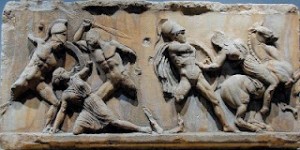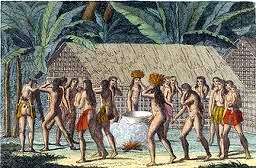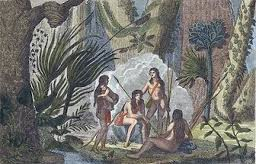Why is it called the Amazon River?
The first occurrence of the Greek word Amazon is in the Iliad, two times, both with the same epithet: ‘Αμαζονας αντιανειρας, Amazons who fight like men. In the centuries following, there were many additional references to armed and mounted women, fierce warriors, fighting the Greeks. Indeed, the αμαζονομαχιες, the battle between Greeks and Amazons, became a favorite theme with vase painters and sculptors of friezes. The women are depicted as beautiful and valiant, usually dressed in short tunics, often open at one side, and often with one breast bare. This convention was presumably to ensure that the viewer knew these figures were women. The Greek warriors, as always, were depicted as fighting naked.
 |
| Greek warriors battling the Amazons |
I have now looked at a bunch of amazonomachies, and I must confess that the constant depiction of naked men slaughtering near-naked women strikes me as deeply creepy. Still, the theme should be placed in the context of similarly popular depictions of Greeks fighting Persians and centaurs. These battle scenes define the ideal of Greek manhood by what it is not — not foreign, not animal, not female.
At some point the word Amazon acquired a folk etymology, and the word was said to be derived from the α- privative and the noun μαζος, breast — thus breastless, related to a tradition, almost certainly false, that the Amazon women burned off their right breast, so that it would not interefere with drawing the bow. There are several reasons to disbelieve this account. Contemporary women certainly manage to be outstanding archers without sacrificing a breast. More important, nowhere in Greek art is there a depiction of a single-breasted Amazon. Rather, there is every reason to believe that the word Amazon is a borrowing into Greek of the Old Persian word hamazan, fight as a group. The Ionian Greeks did not aspirate the first syllable of the borrowed Persian word — hence amazonas.
 |
The large South American river was apparently first given the name Río Santa María de la Mar Dulce by the invading Spaniards around 1500. The term mar dulce, freshwater sea, refers to the fact that the river’s discharge into the ocean is so massive that, even far out from the river’s mouth, the ocean water is not salty. There are then two theories of how the river acquired its current name. Some maintain that the name is from the Tupi or Guarani word transliterated into Portuguese as amassona, boat-breaker, and, again, there are two theories as to the origin of this term. Some say that it refers to the destructive effects of the root systems of some riparian plants; others say that it refers to the tidal phenomenon in the lower Amazon called the proroca, which can produce rapidly advancing tidal waves twelve to fifteen feet high sweeping hundreds of miles upstream. It has been argued that, in either case, an indigenous etymology is not neccessary, since there are already the perfectly good Portuguese verbs amassar, crumple, crush, and amassarse, heap up.
 |
A more likely candidate derives from the 1541 expedition of Francisco de Orellana in search of the legendary city of El Dorado. Accompanying the expedition as its chronicler was a Dominican monk named Gaspar de Carvajal. De Orellana’s ship became separated from the others, and he found his way home by sailing down the Amazon. On the way, he encountered and fought an indigenous people of eastern Brazil called the Tapuya, pictured above in two nineteenth-century prints. To the surprise of the Spaniards, Tapuya women fought beside the men. Here again there are two theories. It is perhaps true that Tapuya women, unlike those among other Amazonian peoples, fought in battles. Perhaps the Spaniards, confronted with beardless long-haired warriors decorated with jewelry, thought that at least some of them were women. In any event, in the chronicle of Gaspar de Carvajal, the Tapuya fighters transmogrified into tall, pale-skinned, blonde-haired, naked female warriors.
Hence the River Amazon.

- Previous Post: An Ayahuasca Documentary
- Next Post: Ancient Andean Hallucinogens
- More Articles Related to: The Amazon


